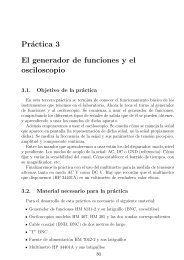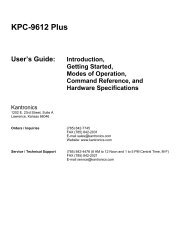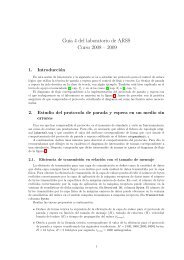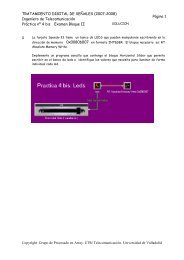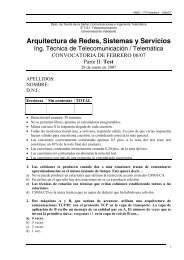Iterative Linear Programming Formulation for Routing and ...
Iterative Linear Programming Formulation for Routing and ...
Iterative Linear Programming Formulation for Routing and ...
Create successful ePaper yourself
Turn your PDF publications into a flip-book with our unique Google optimized e-Paper software.
.previously defined. Let µ be the number of availablehwavelengths. Let ck(h = 1, ... , H; k = 1, ... , µ) be thewavelength assignment variables, with c h k= 1 ifwavelength k is assigned to lightpath h, <strong>and</strong> c h k= 0otherwise. Then, MRA is <strong>for</strong>mulated as follows:k − 1 hH + 1 c(8)∑∑Minimize ( )khsubject to:h∑ c= ∀ h(9)kh h∑ pe ⋅ ck∀ k,e (10)hEquation (9) ensures that every lightpath isassigned a single wavelength. Equation (10) avoidsthat two lightpaths supported by the same fiber link eare assigned the same wavelength k. The objectivefunction (8) maximizes the wavelength reuse, that is,it assigns the same wavelength (those correspondingto the lowest values of k are preferred) wheneverpossible. Hence, some of the µ wavelengths can beunnecessary. Next, we will prove that (8) maximizesthe wavelength reuse. Note that the coefficient ofheach ckin (8) is (H + 1) k – 1 . Besides this, since atmost H different lightpaths can be assigned thehwavelength k, it is verified that ∑ c≤ H ∀ k .hThen,H +k − 1 hck+− 1H 1hc ≤∑ ( 1 )k= ( ) ∑hk 1≤ ( H + ) H < ( H 1) k1 −+ (11)(H + 1) k his the coefficient of ck+ 1∀ h, so (8) will belower if all the lightpaths in the network are assignedthe wavelength k than if a single lightpath is assignedthe wavelength k + 1.3.3 An <strong>Iterative</strong> Algorithm <strong>for</strong> RWA (IRWA)In this section we propose an iterative algorithm(called IRWA) that integrates BWR <strong>and</strong> MRA tosolve the RWA problem. The algorithm attempts tominimize the number of wavelengths needed to routea group of lightpath requests <strong>and</strong> to maximize thewavelength reuse. For a given network <strong>and</strong> <strong>for</strong> a setof lightpath requests, we denote by BWR(M) thesolution obtained when solving BWR <strong>for</strong> thatparticular value of M. If the solution is unfeasible,then BWR(M) = ∅. We also define MRA(R, µ) in thekhksame way, being R = { p h e} a lightpath routingscheme <strong>for</strong> the given requests.IRWA algorithm:Initialization: Let M be some lower bound onthe number of different wavelengths needed.If none is known, then M = 1.While BWR(M) = ∅ BeginM = M + 1End Whileµ = MR = BWR(M)While MRA(R, µ) = ∅ Beginµ = µ + 1End WhileSeveral authors have presented lower bounds onthe number of wavelengths <strong>for</strong> different networks[2,8]. Next, we present a simple lower bound <strong>for</strong>estimating the goodness of IRWA. Given an N-nodesnetwork with the same physical degree θ <strong>and</strong> thesame logical degree T on each node, at most N θlightpaths of one-hop length can be established(supposing that there is at most one lightpath <strong>for</strong> eachpair of nodes), N θ ( θ − 1)of two-hop length, <strong>and</strong> soon. Then, lightpaths of at least D hops must beestablished, being D an integer such as:D−2∑i=0iD−1Nθ ( θ −1)+ N'θ ( θ −1)= NT (12)where N ' is a real number such as 0 < N'≤ N .1(Notice that N'θ ( θ −1)D− is an integer numbermeaning the number of lightpaths of length D). Alightpath consists of a series of lightpath segmentsfrom its source to its destination (one segment <strong>for</strong>each fiber link it traverses). Then, the minimumnumber of lightpath segments in the network is:D−2S = ∑ ( i + 1) Ni=0iD−1θ ( θ −1)+ DN'θ ( θ −1)(13)If we suppose these segments are uni<strong>for</strong>mlydistributed among the 2E unidirectional physical links(i. e., each physical link supports the same number oflightpaths), then the minimum number of lightpathsegments per physical link (which is a lower boundon the number of wavelengths required) is:⎡ S ⎤µ min =(14)⎢2E⎥Note that this is an optimistic lower bound. For eachnode, we are supposing that lightpaths are established






